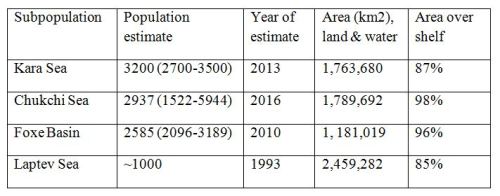 The Chukchi Sea finally has a polar bear population estimate! According to survey results from 2016 only recently made public, about 2,937 bears (1,522-5,944) currently inhabit the region, making this the largest subpopulation in the Arctic.
The Chukchi Sea finally has a polar bear population estimate! According to survey results from 2016 only recently made public, about 2,937 bears (1,522-5,944) currently inhabit the region, making this the largest subpopulation in the Arctic.
This is exciting news — and a huge accomplishment — but the US Fish and Wildlife Service responsible for the work has been oddly mum on the topic.
Not only that, but an extrapolation of that estimate calculated by USFWS researchers for Chukchi plus Alaska (the US portion of the Southern Beaufort Sea subpopulation) was estimated at 4,437 (2,283-9,527), although with “significant uncertainty.”
Nevertheless, it means the 2016 estimate for Alaska could be roughly three times what it was in 2010: a whopping 1,500 or so, up from about 450 (or about 225-650) for the same area estimated during the last survey (Bromaghin et al. 2015: Fig. 5a).
Even if the real number for Alaska is only twice as large (~1,000), that’s still a huge improvement. It would eliminate the Southern Beaufort as the only polar bear subpopulation in the Arctic to have shown a significant decline blamed on human-caused global warming (Crockford 2018).
If the recovery is real, it means the 2004-2006 decline was a temporary fluctuation after all, just like previous declines in the region. I expect, however, that it will take a dedicated SB population survey for officials to concede that point.
There is not yet a detailed report to cite (Regehr et al. in prep), but the numbers were announced at the 10th meeting of the Russian-American Commission on Polar Bears held at the end of July this year (AC SWG 2018) by Eric Regehr (formerly of the US Fish & Wildlife Service, as of 2017 at the University of Washington). [h/t to G.H.]
This was the same report that raised the quota for subsistence hunting in the Chukchi from 58 to 85, based on these new figures, as I discussed last week.
Regehr was quoted as saying:
“Chukchi bears remain larger and fatter and have not seen downward trends in cub production and survival, according to new preliminary information on the health and numbers of bears.”
Recent research on polar bears and their prey has been ongoing in the Chukchi Sea since 2008 (Crawford et al. 2015; Crawford and Quackenbush 2013; Rode and Regehr 2010; Regehr et al. 2010, Rode et al. 2014, 2015, 2018).
Now it’s all coming together to paint a picture of a large population of polar bears in excellent physical condition, with strong reproduction and cub survival (such as triplet litters sighted on numerous occasions), despite a much longer ice-free period in summer than in the 1980s.
Fat bears have been a common summer sight in the Chukchi Sea (see photo below from Sept. 2017 on Wrangel Island) as well as in Alaska. Despite the huge declines in summer sea ice since 2007, Chukchi bears are doing better than OK — they are truly thriving.
Gone now is the “guesstimate” of about 2,000 used by polar bear specialists (but only when they really need one for their models): otherwise, since 2005 the size of the Chukchi was said to be “unknown.”
Given the new estimate, a comparison of the four largest subpopulations (both in the area and population size)1 reveals that the 2013 estimate for the Kara Sea (3,200) is not out of line for its size.
However, the population estimate of 1,000 for the Laptev Sea is more than two decades out-of-date and very low for a region almost 1,000,000 km2 larger in area than the Chukchi and Kara Seas.
See the comparison table of those four subpopulations below, which includes the percentage of each region that lays over the continental shelf (preferred polar bear habitat when it’s ice-covered).2
The Laptev Sea population size estimate stands out as an outlier: is almost certainly home to two or three times as many polar bears, especially after decades of zero legal hunting.


FOOTNOTES.
- These four are the largest only if area and population size are considered together. The Barents Sea is only about 1,158,928 km2 in area, with about 62% over the continental shelf, and an extrapolated population size estimate in 2015 of 3,749 (Aars et al. 2017; Crockford 2018). The Davis Strait is almost as large in area as the Chukchi Sea (1,703,007 km2), with 42% over the continental shelf, but the population size at last count (2007) was 2,158 (1,833-242) (Peacock et al. 2013).
- Kara Sea population estimate is from Matishove et al. (2014), used by the IUCN in their 2015 Red List assessment (Wiig et al. 2015); Chukchi Sea estimate is from AC SWG (2018); Foxe Basin estimate is from Stapleton et al. (2016); and Laptev Sea estimate is from Aars et al. 2006, used by the IUCN in their 2015 Red List assessment (Wiig et al. 2015). Area size and percentage of the area over continental shelf figures are from Hamilton and Derocher (2018).
Read rest at Polar Bear Science





















No wonder they delayed releasing the report, if there had been one bear less it would have made front page news.
I all has to do with politics and money the greens want the money and the power to evict you from your home and turn the area into a refuge for some dumb lizard or rat using the Polar Bear a predator of seals and goslings is just more smoke and mirrors